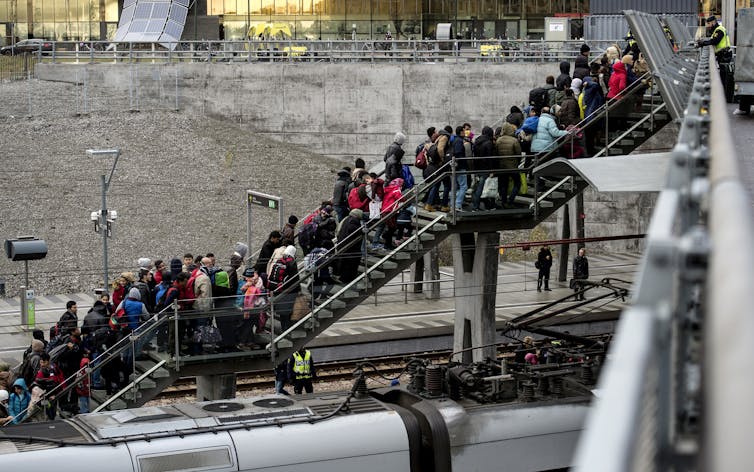US President Donald Trump stunned Sweden recently when he invoked a mystery event that happened in the country furing on of his campaign rallies in Florida. “Look at what’s happening last night in Sweden,” he said. “They took in large numbers. They’re having problems like they never thought possible.”
What was he talking about? Sweden’s US embassy was so concerned they asked the Trump administration for an explanation. The president later said it was related to a report he had seen on Fox News about immigration.
The implication, of course, was that Sweden’s acceptance of large numbers of refugees had led to unspecified terror or crime. This has not been a major issue for the country, but amid the circus around his comments, there is room for a discussion of the real issues that Sweden actually faces in facilitating the integration of recent migrants.

The top choice for migrants
Sweden has long been an outlier in global migration policy, with its relatively open approach and integration schemes based on equal rights.
Unlike some of its neighbouring countries such as Denmark, and many EU countries, Sweden has largely resisted the trend of implementing more restrictive migration and integration policies.
These policies have been part of making Sweden one of the top choices for humanitarian migration, long before the surge in migration to Europe since 2015. Since the early 2000s, no other country has granted international protection to more people per capita
When the Syrian conflict escalated and pushed people to look for a safe haven in Europe, Sweden was again the top choice for many asylum seekers. Between 2014-2015 Sweden saw the largest per-capita inflow of asylum seekers ever recorded in an OECD country.
Shock to the system
But it’s still fair to say the latest rise in immigration caused shocks to the political system. This led the government to adopt several measures that go against long-standing traditions and principles in Sweden, though not to the extent of other countries.
The two most prominent measures were the introduction of external border controls, and new migration legislation adapted to EU minimum standards rather than previous Swedish standards. The border controls will eventually stop, and the new migration law is presented as a three-year interim solution.
It is unclear if this is a genuinely a temporary policy change, or if it is a start of a more long-term redirection of Swedish policies and a convergence with European mainstream migration policies. But experience shows that external shocks are one of the most important prerequisites for major policy changes.

The real challenges
So what are the real challenges facing Sweden as a consequence of the arrival of more than 272,000 asylum seekers over the past three years?
Perhaps the main issue that has been magnified since the start of the Syrian war is the country’s capacity to offer housing, schooling and employment to newly arrived refugees.
The annual budget for migration and integration of the newly arrived in Sweden increased from 15 billion Swedish krona (US$1.7 billion) in 2012 to 63 billion (US$7 billion) in 2016.
The budget has been directed to the reception of asylum seekers and for enlarging the scope of introduction programmes, including language training, civic and job market orientation and a monthly allowance. These programmes are offered for two years to all refugees accepted in Sweden, along with reunited families. Initially, introduction programmes were designed for 16,000 people and it is estimated that 85,000 will be participating in them in 2017.
Before the Syrian war, asylum seekers had to wait for an average of three months to get an answer about their refugee claim. Now, due to high demand, they may have wait for up to a year before that happens. At the end of 2016 there were more than 125,000 unresolved asylum claims. Some asylum seekers decided to move back to their origin countries but most of them stay and wait.
Despite the fact that they are asylum seekers are allowed to work while their claims are being processed, the official employment rate among asylum seekers is lower than 1%.
For the first time in the history of Sweden, the number of unemployed people (in absolute numbers) was higher among foreign-born populations than among those born in Sweden, despite the fact migrants only represent 18% of the total population. This might also be a temporary trend that could reverse once the newly arrived immigrants integrate in the Swedish labour market over the next few years.
Targeted support
A final question related to the challenges of immigrant integration in Sweden is the efficiency of integration policies and, especially, those designed to get newly arrived immigrants into the job market.
The Swedish labour market is oriented towards high-skilled jobs and there is often a mismatch between the skills of newly arrived refugees and those needed in the Swedish labour market.
Introduction programs do not always respond to either the supply or the demand sides of the job market. In order to be more efficient, they need to be more targeted towards the professional skills of participants and, at the same time, more connected to the Swedish labour market.
So yes, Sweden does face challenges based on the large numbers of asylum seekers it has welcomed in recent years. But these challenges have nothing to do with mystery attacks. Instead, the focus is getting them settled and employed.

